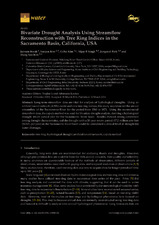| dc.creator | Kwak, Jaewon | |
| dc.creator | Kim, Soojun | |
| dc.creator | Kim, Gilho | |
| dc.creator | Singh, Vijay P. | |
| dc.creator | Park, Jungsool | |
| dc.creator | Kim, Hung Soo | |
| dc.date.accessioned | 2017-10-18T16:35:03Z | |
| dc.date.available | 2017-10-18T16:35:03Z | |
| dc.date.issued | 2016-03-30 | |
| dc.identifier.uri | https://hdl.handle.net/1969.1/164637 | |
| dc.description.abstract | Long-term streamflow data are vital for analysis of hydrological droughts. Using an artificial neural network (ANN) model and nine tree-ring indices, this study reconstructed the annual streamflow of the Sacramento River for the period from 1560 to 1871. Using the reconstructed streamflow data, the copula method was used for bivariate drought analysis, deriving a hydrological drought return period plot for the Sacramento River basin. Results showed strong correlation among drought characteristics, and the drought with a 20-year return period (17.2 million acre-feet (MAF) per year) in the Sacramento River basin could be considered a critical level of drought for water shortages. | en |
| dc.language.iso | en_US | |
| dc.subject | tree ring | en |
| dc.subject | hyrological drought | en |
| dc.subject | artificial neural network | en |
| dc.subject | copula method | en |
| dc.title | Bivariate Drought Analysis Using Streamflow Reconstruction with Tree Ring Indices in the Sacramento Basin, California, USA | en |
| dc.type | Article | en |
| local.department | Biological and Agricultural Engineering (College of
Agriculture and Life Sciences) | en |
| dc.identifier.doi | 10.3390/w8040122 | |


